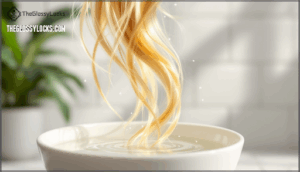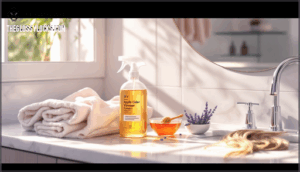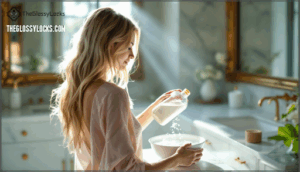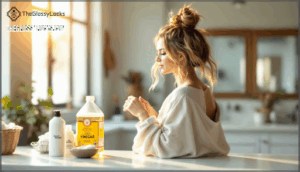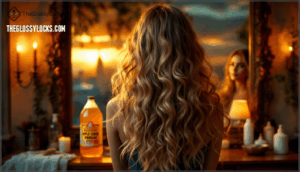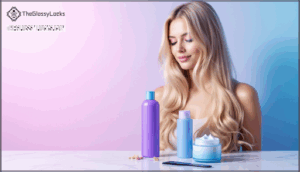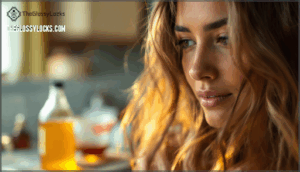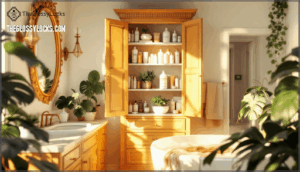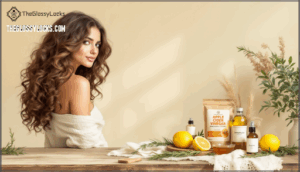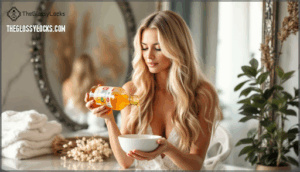This site is supported by our readers. We may earn a commission, at no cost to you, if you purchase through links.
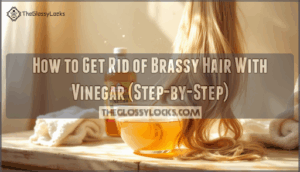
This simple acid treatment closes your hair cuticles, locks in pigment, and neutralizes the oxidation that turns your blonde brassy, all for a fraction of what you’d spend on purple shampoo.
Table Of Contents
- Key Takeaways
- What Causes Brassy Hair?
- Why Vinegar is Effective for Treating Hair Brassiness
- How to Make a Vinegar Hair Toner
- How to Use Vinegar to Get Rid of Brassy Hair
- Can Vinegar Remove Orange Hair Brassiness?
- Alternatives to Vinegar for Toning Brassy Hair
- Potential Risks and Precautions of Using Vinegar on Hair
- Additional Benefits of Using Vinegar on Hair
- Combining Vinegar With Other Natural Remedies for Brassy Hair
- How Long Does It Take to See Results With Vinegar Toning?
- Frequently Asked Questions (FAQs)
- How to get rid of brassy hair with vinegar?
- What are the best brassy hair home remedies?
- What do you use to prevent your hair from going brassy?
- Does olive oil help brassy hair?
- Can apple cider vinegar help with hair dye?
- Can I use vinegar on color-treated hair?
- How often should I use a vinegar rinse?
- Is there a different method for lightening orange hair with vinegar?
- Does vinegar rinse work on all hair types?
- What if vinegar doesnt fix my brassiness?
- Conclusion
Key Takeaways
- Vinegar works by balancing your hair’s pH (bringing it from 9-10 down to the ideal 4-5 range), which closes cuticles, locks in color, and neutralizes the oxidation that causes brassy tones without expensive salon treatments.
- Apple cider vinegar removes up to 90% of mineral buildup from hard water when used weekly in a 1:3 vinegar-to-water ratio, which directly eliminates the deposits that intensify yellow and orange hues in blonde hair.
- You’ll see subtle improvements after one or two treatments, but consistent weekly use over 3-4 weeks delivers the best results—vinegar is a marathon approach to toning, not an overnight fix.
- While vinegar reduces orange brassiness by 15-25%, it’s not as powerful as purple or blue shampoos (which deliver over 70% tonal correction), making it best for maintenance rather than dramatic color shifts.
What Causes Brassy Hair?
Ever wonder why your freshly dyed blonde hair starts looking brassy and dull just weeks later? Brassiness happens when cool tones fade and underlying warm pigments—yellows and oranges—take over. Dye oxidation is the main culprit.
Up to 84% of color fading comes from exposure to oxygen and UV damage, which breaks down the pigments you worked hard to get. Mineral deposits from hard water add another layer of trouble. Water with iron as low as 0.3 mg/L can shift your tone noticeably.
Most color fading—up to 84%—stems from oxygen and UV exposure, while even trace minerals in hard water can visibly alter your tone
Chemical exposure from chlorine, heat styling, and harsh shampoos strips your color even faster, while hair porosity makes bleached strands absorb all these enemies more easily. The result? Hair discoloration that leaves you reaching for a fix. Using a purple shampoo can help neutralize these brassy tones.
Why Vinegar is Effective for Treating Hair Brassiness
You might wonder why something as simple as vinegar works on brassy hair when expensive salon products promise the same results.
The answer lies in vinegar’s chemistry and how it interacts with your hair structure. Here’s what makes vinegar such a powerful tool against unwanted warm tones.
PH Balancing Properties
When your hair goes through bleaching or coloring, it can swing from its best pH range of 4–5 all the way up to around pH 9–10. That’s where vinegar steps in. With a pH of 2–3, vinegar helps bring your hair back down to that ideal point, restoring cuticle integrity and locking in your color.
Apple cider vinegar works especially well here because it neutralizes the dye alkalinity left behind from chemical treatments. By balancing your hair pH, you’re doing more than fighting brassy tones—you’re actually helping reduce porosity. When your cuticles lie flat in that acidic environment, they trap color molecules inside and keep those unwanted warm tones from creeping back in.
Studies show this kind of pH modulation leads to smoother, glossier hair with way less color fading over time. It can also provide benefits for hair, from adding shine to encouraging hair growth.
Removal of Mineral Buildup
If you live in an area with hard water—where calcium and magnesium run high—those minerals land on your hair shaft and refuse to budge. Over time, they pile up and intensify warm, yellow hues, leaving your blonde or lightened hair looking dull and orange.
That’s where vinegar steps in. The acetic acid in apple cider vinegar acts like a magnet for these deposits, breaking them down through a process called chelation. When you use a 1:3 vinegar-to-water rinse consistently once a week, you can strip away up to 90% of that stubborn mineral buildup.
People dealing with hair damage from hard water report a 35–40% boost in brightness after switching to acid-based rinses. Here’s what happens when you clear away those minerals:
- Light bounces evenly off your strands instead of scattering through cloudy deposits
- Cool tones resurface as the dull, orange undertone fades
- Your hair feels cleaner and lighter, like a weight’s been lifted
By removing what dulls your color, vinegar lets your true tone shine through.
Toning Effects
Beyond clearing buildup, vinegar brings genuine toning power to your color. The acid gently oxidizes residues that create those yellow or orange reflections, refining your shade without adding pigment. At a pH of 3–4, it brightens blonde or gray hair naturally—a kind of acid brightening that extends the life of professional toning by 20–25%.
Want to DIY? Mix apple cider vinegar with a few drops of blue or purple food coloring and you’ve got a homemade toner that counteracts warm undertones. The organic acids—malic and acetic—work together to promote tonal balance, giving you that neutral, cool-toned sheen.
This isn’t a quick fix, though. Consistent use is what locks in pigment clarification and keeps your color true.
How to Make a Vinegar Hair Toner
Making your own vinegar toner at home is simple and doesn’t require special ingredients. You’ve got two solid options depending on what you already have in your pantry.
Let’s break down both recipes so you can pick the one that works for you.
Apple Cider Vinegar Toner Recipe
If you’re chasing that cool-toned blonde look without dropping salon cash, apple cider vinegar might just be your secret weapon. This homemade remedy combats brassy hair by balancing pH and removing buildup that traps warm tones.
Here’s what you need:
- 2 tablespoons of ACV – the acidic hero that closes cuticles and restores shine
- 1 cup of water – dilutes the acid to safe levels (standard ACV dilution ratios work here)
- Optional: 1 teaspoon honey – adds moisture and prevents dryness
- Optional: 2-3 drops of lavender oil – masks the vinegar smell
Mix your recipe ingredient variations in a spray bottle for easy application. Apply this hair toner to damp, freshly washed hair, focusing on brassy sections. Cover with a shower cap and leave for 15-30 minutes.
The toner application methods matter—longer contact time means better toning effects. Rinse thoroughly with cool water.
For DIY toner storage, keep your mixture refrigerated for up to one week. The ACV rinse benefits extend beyond color correction—you’ll notice smoother strands and improved scalp health too.
White Vinegar Rinse Recipe
When blonde hair starts throwing unwanted warmth your way, white vinegar cuts through the brassiness like nobody’s business. This vinegar type is stronger than apple cider vinegar, making it ideal for stubborn orange tones that won’t quit.
Here’s your homemade remedy:
- 2.5 cups white vinegar mixed with 12 drops blue food coloring and 3 drops red creates a DIY toner that neutralizes brass
- Standard rinse: 1 part vinegar to 2-3 parts water for weekly maintenance without the added ingredients
- Apply to damp hair after shampooing, massage through for 3-5 minutes, then rinse with cool water (rinse temperature matters for sealing cuticles)
- Store your mixture refrigerated in a glass bottle for up to two weeks—proper storage methods keep it effective
Recipe variations depend on your brassiness level. For mild warmth, dilute more. For aggressive orange, use the food coloring version.
Using vinegar for hair this way gives you salon-level toning at home. The acidity strips mineral buildup while removing brassiness from hair without harsh chemicals.
How to Use Vinegar to Get Rid of Brassy Hair
Now that you know what vinegar can do for brassy hair, let’s walk through the actual process. You’ll need to mix it properly and apply it the right way to see results.
Here’s how to get started with both the dilution method and the best timing for your treatments.
Dilution and Application Process
You don’t need a chemistry degree to mix up a vinegar treatment that actually works—just water, vinegar, and a few minutes of your time. Start by creating a diluted ACV solution using apple cider vinegar and water at a 1:2 ratio. Pour one part vinegar into two parts water in a spray bottle or bowl.
After shampooing, apply the mixture to damp hair, focusing on areas where brassiness shows up most. Work it through from roots to ends, making sure every strand gets coated. Let it sit for 2-5 minutes—this gives the vinegar concentration enough time to balance your hair pH without causing scalp sensitivity.
Rinse thoroughly with cool water until the vinegar smell fades completely. Using apple cider vinegar this way helps with treating brassy hair while keeping your color fresh.
Duration and Frequency of Use
Timing makes all the difference between toned hair and fried strands—too much vinegar too often strips your color instead of saving it. Stick to once or twice weekly for the ideal frequency when treating brassy hair with apple cider vinegar.
Leave the rinse on for 2-5 minutes max—rinse duration matters because longer application timing won’t boost results, just risks hair damage.
Consistent usage guidelines over several weeks deliver long-term effects that keep brassiness away while maintaining your hair pH balance. Cool water flushes away residue completely, protecting your color investment without overworking your strands.
Can Vinegar Remove Orange Hair Brassiness?
Vinegar can reduce orange brassiness, but it’s not a miracle fix. Studies show that apple cider vinegar rinses lower visible orange tones by roughly 15–25% after a few treatments—thanks to its ability to strip away mineral buildup and balance your hair’s pH.
That said, vinegar alone won’t neutralize strong orange pigments the way blue or purple toners do. Those cool-toned products deliver over 70% tonal correction, making them far more effective for serious brass removal.
Still, regular ACV rinses every two weeks help maintain tone and prevent oxidation long-term, especially if you’re dealing with hard water.
Alternatives to Vinegar for Toning Brassy Hair
Vinegar works well, but it’s not your only option for fighting brassy tones. Purple and blue shampoos offer a more targeted approach, while natural remedies like lemon juice can brighten your color from a different angle.
Let’s look at what else you can use to keep those warm tones under control.
Purple/Blue Shampoos
If vinegar sounds too fussy or you want something stronger, purple and blue shampoos are your next best move. These products work by depositing cool-toned pigments directly onto your hair during a regular shampoo application. Purple shampoo combats yellow brassiness in blonde hair, while blue shampoo neutralizes orange tones.
Here’s what makes them worth trying:
- They’re foolproof – Just swap your regular shampoo once or twice a week, lather up, wait three to five minutes, and rinse. No mixing or measuring required.
- You’ll see results fast – Most people notice less brassy hair after just one or two washes, making this approach quicker than vinegar rinses.
- They protect while they tone – Quality formulas include ingredients that nourish your strands while fighting brassiness, so you’re not choosing between color correction and hair health.
When comparing products for blonde maintenance, check the ingredient analysis. Sulfate-free options are gentler and won’t strip your color as quickly.
Lemon Juice and Honey Mask
For a gentler approach that adds moisture while fighting brass, lemon juice and honey make an effective DIY mask that works differently than chemical toners. This home remedy combines two ingredients you probably already have in your kitchen.
Here’s how to prepare your mask: Mix equal parts fresh lemon juice with raw honey until you get a smooth consistency. The lemon acidity works like vinegar to rebalance your hair’s pH, while honey benefits include deep hydration and natural shine enhancement.
Apply this mixture to damp, freshly shampooed hair, working it through from roots to ends. Focus on the brassiest sections. Leave it on for 20 to 30 minutes, then rinse thoroughly with cool water.
The expected results? You’ll notice subtly cooler tones and softer texture after two to three treatments. This mask won’t give you dramatic color changes like purple shampoo, but it’s perfect if you want gradual correction without stripping your hair. Use it weekly to maintain your tone while keeping your strands nourished.
Potential Risks and Precautions of Using Vinegar on Hair
While vinegar can work wonders on brassy hair, it’s not risk-free. Apple cider vinegar has a pH of 2–3, which means undiluted applications can cause scalp irritation, burning, or even chemical burns in severe cases. About 27% of people with sensitive skin report increased irritation from vinegar-based treatments.
Overuse strips your hair’s natural oils, leading to dryness and brittleness—sometimes a 40% increase in dryness with frequent weekly applications. This affects your hair cuticle and can result in breakage and split ends.
If you have color-treated hair, be cautious. Vinegar can accelerate color fading by up to 30% and may create uneven tones. Always dilute it properly—one to two tablespoons per cup of water—and limit use to once or twice weekly. Apply for no more than five minutes, then rinse thoroughly.
Patch test first, especially if you have existing scalp conditions. If you notice persistent burning, rashes, or unusual hair loss, stop immediately and consult a dermatologist. Safe usage means respecting vinegar’s strength while protecting your hair’s integrity.
Additional Benefits of Using Vinegar on Hair
Vinegar doesn’t just tackle brassiness—it brings some solid bonuses to your hair care routine. Beyond neutralizing those unwanted orange and yellow tones, it works behind the scenes to improve your scalp and transform your hair’s texture.
Here’s what else you’re getting when you add vinegar to your regimen.
Improved Scalp Health
Beyond just neutralizing brassy tones, vinegar works double duty by transforming your scalp into a healthier environment from the roots up. Apple cider vinegar balances your scalp’s pH levels, which creates conditions where bacteria and fungi struggle to thrive. This natural acidity helps prevent scalp infections before they start.
You’ll notice fewer dandruff flakes too. The antibacterial properties in vinegar tackle the root causes of flakiness and itchiness that often plague color-treated hair. When your scalp health improves, your hair follicles get better access to nutrients, which can foster healthier hair growth over time.
Regular vinegar rinses also clear away product buildup that clogs pores and weighs down your roots. This deep-cleaning action lets your scalp breathe while maintaining the protective acid mantle that keeps irritation at bay. It’s a simple step that pays off with a cleaner, more comfortable scalp that fosters vibrant, healthy hair.
Enhanced Shine and Smoothness
Once your scalp is in better shape, you’ll see the payoff in how your hair looks and feels—smoother strands that catch the light like they’re meant to. Vinegar benefits your hair cuticle by sealing it flat, which boosts manageability and creates better light reflection. When the hair pH balances out, you’ll notice improved shine that lasts. Apple cider vinegar delivers these long-term effects without stripping your color.
- Cuticle smoothing locks in moisture and prevents frizz
- Enhanced hair shine from improved light reflection off sealed cuticles
- Better manageability when detangling and styling
- Lasting softness that builds with consistent vinegar rinses
Combining Vinegar With Other Natural Remedies for Brassy Hair
You can boost vinegar’s toning power by teaming it up with other natural ingredients that tackle brassiness from different angles. A honey vinegar mask softens hair while the apple cider vinegar clarifies, or try a baking soda boost before your vinegar rinse to strip stubborn mineral buildup. An oil vinegar blend—jojoba or coconut mixed with your ACV—protects moisture as it tones. A tea vinegar rinse adds natural pigments that cool down warm tones, and a lemon vinegar mix amplifies lightening effects.
These home remedies for brassy hair work best with consistency—rotate them into your hair care routine every week or two for maximum impact.
How Long Does It Take to See Results With Vinegar Toning?
Most people wonder if vinegar toning delivers overnight miracles or requires weeks of patience—and the honest answer falls somewhere in between. Here’s what to expect:
- Initial Improvement: You’ll notice subtler brassy hair tones after your first or second apple cider vinegar rinse.
- Consistent Application: Weekly treatments show the best results for treating brassy blonde hair within 3-4 weeks.
- Hair Porosity: More porous hair absorbs vinegar faster, speeding up the toning process.
- Vinegar Type: White vinegar works quicker than ACV but can be harsher on damaged strands.
- Damage Level: Severely compromised hair needs more time to respond to any hair brassiness treatment.
Don’t expect magic overnight—think of vinegar as a marathon, not a sprint.
Frequently Asked Questions (FAQs)
How to get rid of brassy hair with vinegar?
Brassy tones sneak up on blonde hair when mineral buildup from hard water, sun exposure, and fading dye reveal unwanted yellow or orange hues underneath your color—but vinegar’s acidity cuts through that buildup effectively.
What are the best brassy hair home remedies?
Kitchen staples like baking soda and olive oil work wonders for brassy hair.
Try an ACV mask, homemade toner with food coloring, or a tea remedy to neutralize unwanted warm tones naturally and affordably.
What do you use to prevent your hair from going brassy?
Preventing brassy hair starts with color-safe products and sulfate avoidance. Install shower filters to block minerals, apply UV protection before sun exposure, and deep condition weekly.
These hair care habits keep apple cider vinegar treatments working longer for hair color maintenance.
Does olive oil help brassy hair?
Olive oil won’t directly neutralize brassy tones, but it strengthens hair and locks in moisture—think of it as armor against future damage.
It works best paired with vinegar or purple shampoos for thorough color protection.
Can apple cider vinegar help with hair dye?
ACV doesn’t change hair dye directly, but a diluted ACV solution before dyeing can clarify your strands and help color take more evenly.
Post-dye ACV use aids dye longevity by sealing the cuticle and removing residue that dulls color.
Can I use vinegar on color-treated hair?
Color-treated hair can tolerate vinegar, but timing and dilution concerns matter. ACV works well on dyed strands when you mix it right—one part vinegar to two or three parts water protects your hair pH level while fighting brassiness.
Test a small section first, rinse thoroughly with cool water, and follow up with a nourishing conditioner for proper post-treatment care.
How often should I use a vinegar rinse?
Once or twice a week works well for most hair types.
Your individual rinse frequency factors depend on your hair’s porosity and scalp sensitivity considerations—overly porous hair might need the diluted ACV solution more often to maintain hair pH level and combat brassy hair.
Is there a different method for lightening orange hair with vinegar?
White distilled vinegar offers stronger toning power for stubborn orange shades.
Combine half a cup of vinegar with one cup of water, then apply after shampooing. Let it sit for three to five minutes before rinsing thoroughly with cool water.
Does vinegar rinse work on all hair types?
Vinegar rinses work well across different hair types, though results vary based on hair porosity and texture. If you have high-porosity or color-treated hair, you’ll notice faster toning of brassy hair because the cuticles absorb apple cider vinegar benefits more readily. Low-porosity hair needs slightly longer application times.
Those with scalp sensitivity should use weaker dilutions to avoid irritation, while pre-existing damage requires extra caution since vinegar’s acidity affects the hair pH balance differently on compromised strands.
What if vinegar doesnt fix my brassiness?
If vinegar doesn’t work, you might need professional treatments or alternative toners.
Sometimes underlying causes like severe damage or hair porosity issues require a hair salon visit for proper hair color correction beyond what home remedies can fix.
Conclusion
Picture your blonde looking like sunlight on cool water instead of a fading penny—that’s the difference a vinegar rinse makes. Learning how to get rid of brassy hair with vinegar gives you control over your color without draining your wallet on salon visits.
Mix your solution, apply it consistently, and watch those warm tones disappear as your cuticles tighten and your color settles back into the shade you chose. Your mirror will show you what proper pH balance can do.
- https://www.reddit.com/r/HaircareScience/comments/1i8zo43/why_does_acv_lighten_hair/
- https://www.buywow.in/blog/brighten-your-gray-hair
- https://arcticfoxhaircolor.com/blogs/news/how-to-tone-orange-hair
- https://nationalplanningcycles.org/what-home-remedy-gets-rid-of-brassy-hair-natural-solutions-that-work/
- https://brilliantsilverwhite.com/2022/05/31/several-benefits-of-traditional-hair-toner/

